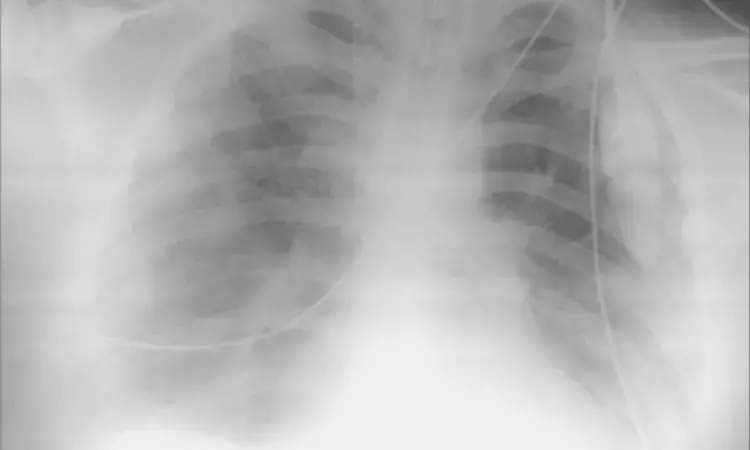- Home
- Medical news & Guidelines
- Anesthesiology
- Cardiology and CTVS
- Critical Care
- Dentistry
- Dermatology
- Diabetes and Endocrinology
- ENT
- Gastroenterology
- Medicine
- Nephrology
- Neurology
- Obstretics-Gynaecology
- Oncology
- Ophthalmology
- Orthopaedics
- Pediatrics-Neonatology
- Psychiatry
- Pulmonology
- Radiology
- Surgery
- Urology
- Laboratory Medicine
- Diet
- Nursing
- Paramedical
- Physiotherapy
- Health news
- Fact Check
- Bone Health Fact Check
- Brain Health Fact Check
- Cancer Related Fact Check
- Child Care Fact Check
- Dental and oral health fact check
- Diabetes and metabolic health fact check
- Diet and Nutrition Fact Check
- Eye and ENT Care Fact Check
- Fitness fact check
- Gut health fact check
- Heart health fact check
- Kidney health fact check
- Medical education fact check
- Men's health fact check
- Respiratory fact check
- Skin and hair care fact check
- Vaccine and Immunization fact check
- Women's health fact check
- AYUSH
- State News
- Andaman and Nicobar Islands
- Andhra Pradesh
- Arunachal Pradesh
- Assam
- Bihar
- Chandigarh
- Chattisgarh
- Dadra and Nagar Haveli
- Daman and Diu
- Delhi
- Goa
- Gujarat
- Haryana
- Himachal Pradesh
- Jammu & Kashmir
- Jharkhand
- Karnataka
- Kerala
- Ladakh
- Lakshadweep
- Madhya Pradesh
- Maharashtra
- Manipur
- Meghalaya
- Mizoram
- Nagaland
- Odisha
- Puducherry
- Punjab
- Rajasthan
- Sikkim
- Tamil Nadu
- Telangana
- Tripura
- Uttar Pradesh
- Uttrakhand
- West Bengal
- Medical Education
- Industry
Chest x-ray has lower sensitivity for detecting thoracic injury in children exposed to blast

U.K.: Chest CT is better than chest X-ray (CXR) for identifying blast injuries in children exposed to blast, a recent study in the journal Injury has revealed.
The study found that for identifying significant thoracic Injury in children who have experienced blast injuries, chest X-ray has a poor sensitivity necessitating a low threshold for C.T. chest use for such patients.
Paediatric thoracic trauma is not common in civilian practice. It is dominated by a blunt mechanism of Injury (MOI). Still, it is common in war and is a significant cause of mortality and morbidity in children exposed to blast injury. These injuries must get recognized in the early stages. Several studies have investigated the sensitivity of chest X-rays for chest injury detection in blunt trauma, but none have evaluated its performance in pediatric blast injury.
Against the above background, Will Sargent and Iain Gibb from the Centre for Blast Injury Studies in Imperial College London, London, UK, compared CXR findings to the 'gold standard computed tomography (C.T.) for detecting significant thoracic injuries among 103 children who got injuries from the blast and presented to a U.K. Role 3 Hospital at Camp Bastion in Afghanistan during the conflict in Afghanistan from 2011-2013.
Significant thoracic injuries were defined as haemothorax, pneumothorax, great vessel or aortic Injury, ruptured diaphragm, two or more rib fractures, sternal fracture, pulmonary contusion, and penetrating fragments.
The study led to the following findings:
· CXR's sensitivity for the detection of significant injuries was: subdermal metallic fragments 75%, haemothorax 40%, blast lung 80%, laceration 100%, contusion 44%, and pneumothorax 43%.
· CXR missed all cases of ≥2 rib fractures, diaphragm injury, pleural effusion, and clavicle fracture, although the numbers of each were small.
· Specificity for chest X-ray injury detection was 93% for the fragment and 94% for contusion, and 100% otherwise.
· The Specificity and sensitivity of chest X-ray for the identification of an abnormality that would prompt C.T. imaging were 82% and 72%.
"The findings stress that chest computed tomography is still the better modality for the evaluation of children injured in war conflict," the authors wrote.
The authors argued that there should be a low threshold for using chest C.T. in evaluating children exposed to blasts, given the challenge of injured children's clinical assessment and the prospective for severe adverse consequences of missed thoracic injuries.
Reference:
The study "The sensitivity of chest x-ray (CXR) for the detection of significant thoracic injury in children exposed to blast" was published in Injury, International Journal of the Care of the Injured.
DOI: https://doi.org/10.1016/j.injury.2022.12.001
Dr Kamal Kant Kohli-MBBS, DTCD- a chest specialist with more than 30 years of practice and a flair for writing clinical articles, Dr Kamal Kant Kohli joined Medical Dialogues as a Chief Editor of Medical News. Besides writing articles, as an editor, he proofreads and verifies all the medical content published on Medical Dialogues including those coming from journals, studies,medical conferences,guidelines etc. Email: drkohli@medicaldialogues.in. Contact no. 011-43720751


